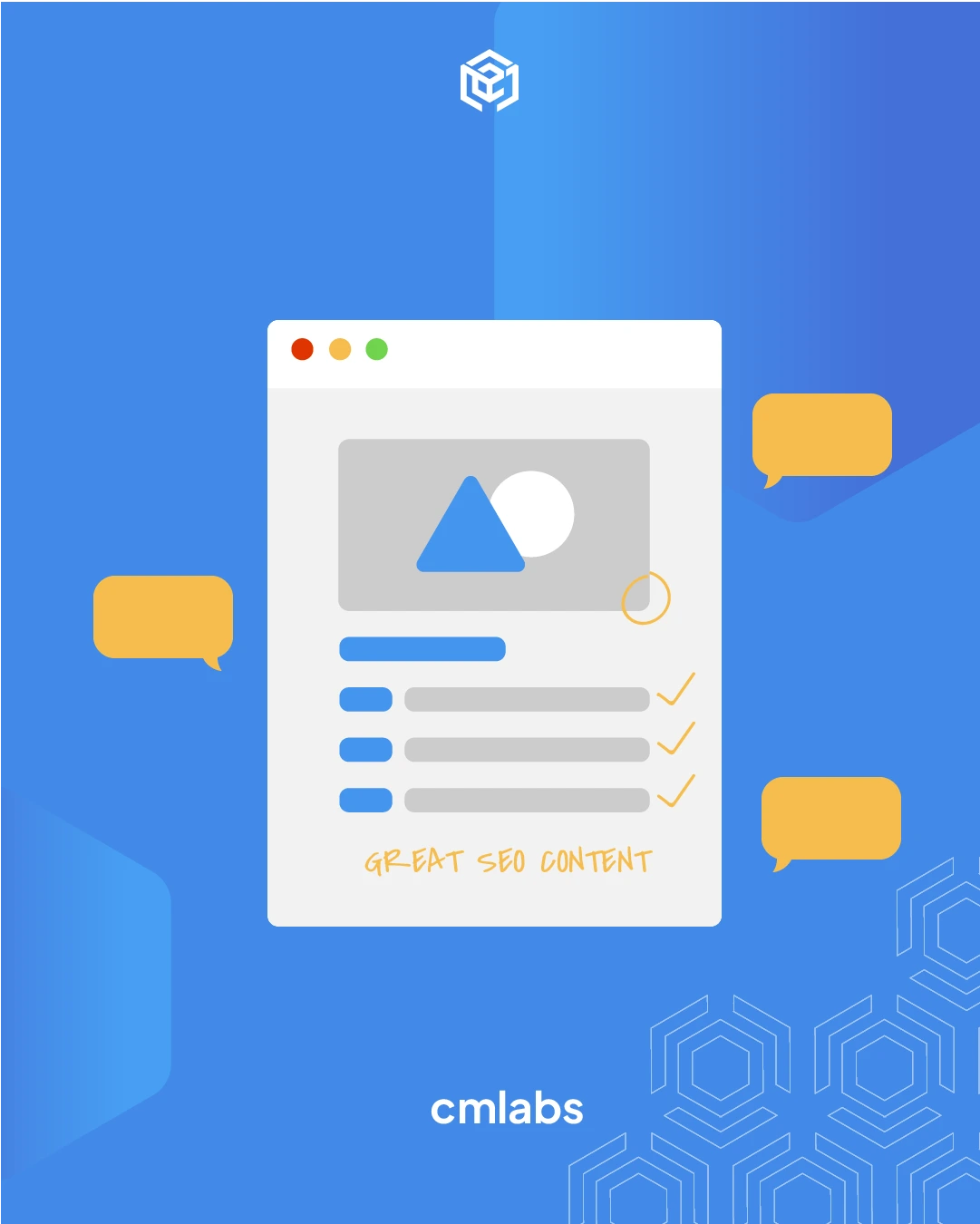We use cookies
This site uses cookies from cmlabs to deliver and enhance the quality of its services and to analyze traffic..
SEO SERVICES
Conduct in-depth technical website audits, strategically develop website projections, and increase your website authority.
ASO SERVICES
Elevate Your App’s Presence with Our Expert ASO Services – Boost Visibility and Drive Downloads!
WRITING SERVICES
We offer a variety of writing services to suit different business necessities. Reach broader audiences or lead specific industries? We've got you covered!
Get relevantly positive media exposure from bloggers and online publishers to increase your brand mentions on search engine results pages.
SEOlutions
A unified source of truth!
SEO & Digital Maternity Solution
SEO & Digital Maternity Solution: Leverage Cross-Platform Insights to Elevate Your Strategy with Expert Consultation
SEO & Digital Maternity Solution
Data Solution options:
Starting from Rp200 mio
Reinventing how a company get creative treatments
A new way to get your creative needs done. Agile team, efficient cost, and expedient way in a flexible yet scalable subscription plan!
Creative-as-a-Services
CaaS package options:
Based on Subscription
Pioneer in digital marketing software powerhouse
We’re excited to unveil our new range of Tech Solutions designed to drive your digital success. Whether you’re looking to enhance your website’s performance, streamline your tech stack, or unlock deeper insights from your data, we’ve got you covered.
Starting from Rp250 mio
Our Clients
Research and innovation center for digital transformation
Digital marketing combines technical skills and business knowledge at every stage. For marketing teams, improving budget management efficiency is crucial, as time is an invaluable resource that should be used wisely. At Sequence, we are dedicated to empowering you to optimize efficiency and strategic planning, ultimately enhancing the impact of your digital marketing efforts.
Subscription-based (IDR1,800/keyword)
Our Clients
BeyondSEO
References
SEO Tools for Webmasters
SEO Tools for Writers
SEO Tools
FIND THE SUITABLE PARTNERSHIP FOR YOUR COMPANY
Check out which cmlabs partnership program suits your company
WHITE LABEL SEO
for CorporateYour company is granted exclusive partnership rights to provide SEO services to our important clients, and we will provide a dedicated backend team to support your efforts.
AFFILIATE PROGRAM
for BizdevA new affiliate program is being introduced for skilled marketers and individuals with strong networks, offering commissions of up to 7% for generating profits independently.
DIGITAL AGENCY
for Marketing Partnerscmlabs is an essential partner for digital agencies, providing a unique selling proposition in Search Engine Optimization (SEO).
BACKLINK PARTNERSHIP
for Media / BloggerWe have a vast database of bloggers and media outlets across Indonesia, categorized by region and media type, giving our clients an edge in managing their media and SEO activities.
OFFICIAL TRAINING
We provide ongoing professional development and support to SEO professionals to ensure they are equipped to meet market demands.
JOIN AS CONTRIBUTOR
for Content WriterGreat opportunity for SEO Writers around the world. T&C applied!
ACADEMIC PARTNERSHIP
Through partnerships with universities in Indonesia, cmlabs has helped align academic curricula with industry demands.
Partnership
Sector & Industries
Tell us your SEO needs, our marketing team will help you find the best solution
As an alternative, you can schedule a conference call with our team
Schedule a Meeting?Contact
Survey
We use cookies
This site uses cookies from cmlabs to deliver and enhance the quality of its services and to analyze traffic..
Last updated: Dec 20, 2023

Before exploring the differences between SQL vs NoSQL, let's first learn the definitions of what is SQL and NoSQL
SQL stands for Structured Query Language, a programming language that plays a crucial role in storing, managing, accessing, and modifying relational-based data.
In the realm of computer technology and networks, SQL is a programming language that has ANSI (American National Standard Institute) standardization and has been around since 1970.
When it was first launched, this query language was still called SEQUEL (Structured English Query Language). However, shortly afterward, the name SEQUEL was changed to SQL for easier pronunciation.
SQL has been around for decades and remains one of the most frequently used programming language options to this day.
Many databases follow the basic SQL guidelines, including PostgreSQL, MySQL, Oracle, and Microsoft SQL Server.
SQL is a database paradigm that focuses on data accuracy and structure by establishing a strict schema.
This means that the structure and relationships between tables must be defined in advance. In short, in the SQL system, data is stored in related tables, and queries are performed using SQL statements.
This is why SQL is considered a programming language suitable for handling complex data with intricate relationships.
NoSQL is a database paradigm designed to meet the needs of complex performance, especially in managing large amounts of data with an uncertain schema.
Not Only SQL or NoSQL is a non-relational database management system (DBMS) that is well-suited for handling big data and is often subject to frequent changes over time.
Due to these advantages, many large companies like Google and Facebook have been proven to use NoSQL in their database management processes.
The reason for this is that NoSQL can proactively support web applications and all changes in the data that occur in real-time.
Some examples of NoSQL databases are MongoDB, Cassandra, and Redis, which are considered more flexible for storing and accessing data as they do not require complex queries.
After understanding the basic definitions of what is NoSQL and SQL, let's delve deeper into their differences. Here are 7 differences between SQL and NoSQL along with comprehensive explanations:
The first difference between SQL and NoSQL can be observed in their structures. One characteristic of NoSQL databases is having a much more flexible structure. In NoSQL, managed data can even be stored in graph databases, documents, or key-value stores.
On the other hand, SQL follows a relational database structure. This means that data is stored in rows, columns, and tables in a structured manner. In fact, the table structure must be defined in advance before inputting data.
Since NoSQL is a flexible option, it can use various languages depending on the type of database.
For example, the MongoDB database uses the JSON format and provides APIs based on JavaScript, Python, and others.
On the contrary, SQL uses the standard query language to manipulate data in relational databases.
This language has become an industry standard and is widely used in various relational database systems. SQL queries include statements such as SELECT, INSERT, UPDATE, and DELETE to perform operations on data.
Another difference between SQL vs NoSQL lies in their usage. In broad terms, NoSQL is often used in web apps that require high loading speed, such as on game web pages, IoT, and some social media platforms.
On the other hand, SQL is a more suitable option for business, communication, or financial applications that require high data integrity and tend to be complex.
Costs are a critical factor in database system management. The difference between SQL vs NoSQL in terms of costs can significantly impact the development and operational decisions of an application.
From a financial perspective, NoSQL is often considered a more economical choice because it provides many open-source platforms.
One advantage of implementing a NoSQL database is that it can be downloaded and used without significant licensing costs.
Additionally, maintenance costs for NoSQL are quite affordable because they do not require administrators with high-level skills.
In contrast to NoSQL, the budget required for SQL tends to be higher because users have to incur additional costs for software licenses, making it less suitable for small and medium-sized enterprises.
One fundamental difference between SQL vs NoSQL can also be seen in how they handle data schemas.
In SQL, the data schema is a crucial aspect and must be determined before data is inserted into the database. This means that every table structure, the relationship between tables, and data type must be defined strictly from the beginning.
This approach can enhance high accuracy in data structure, but it can sometimes be a constraint, especially when users need to make changes to the established schema.
On the other hand, NoSQL offers a much more flexible approach when it comes to data schema. NoSQL databases do not require a fixed schema as predetermined. This way, the development team can store data with different structures in one collection or table.
In addition to covering data structure and flexibility, another difference between SQL and NoSQL lies in the level of security when in use.
One characteristic of SQL is its high level of security, supported by various integrated security mechanisms.
SQL provides features such as authentication, authorization, and encryption to protect data from unauthorized access and minimize the risk of data theft.
On the other hand, security in NoSQL is often considered less robust. NoSQL is designed to handle large data volumes, so some implementations may sacrifice certain aspects of security.
Nevertheless, some NoSQL databases now provide encryption activation options to control access and enhance data security.
The difference between SQL vs NoSQL can also be seen in the support and communities that use them.
SQL, being one of the more well-known query languages, is undoubtedly supported by a large community.
It also has a stable codebase and is equipped with industry standardization that proves its quality.
Due to its popularity, users can easily obtain a wealth of information, tutorials, and documentation related to SQL.
Relational SQL is generally developed by large vendors or exclusively owned by a company. In contrast, NoSQL has a shared community that ensures sustainability and organic development.
NoSQL is a database that uses the BASE (Basically Available, Soft State, and Eventually consistent) consistency model.
This means that NoSQL prioritizes availability and data partitioning in the database system. Here is a further explanation of the BASE concept:
With this approach, NoSQL can ensure more flexibility for users in partitioned conditions by allowing some parts of the system to continue functioning even in the event of failure or network partition.
Meanwhile, SQL consistency uses the ACID model (Atomicity, Consistency, Isolation, Durability) that emphasizes a high level of consistency. Further details of the ACID model are as follows:
This means that every transaction must adhere to rules under specific conditions before being considered successful.
ACID consistency ensures that each transaction originates from an atomic entity. In other words, if a failure or error is detected.
WDYT, you like my article?
Couldn't find result for "Mulki" try to search with different keyword
Suggestion:
Tell us your SEO needs, our marketing team will help you find the best solution
As an alternative, you can schedule a conference call with our team
Schedule a Meeting?



cmlabs Jakarta Jl. Pluit Kencana Raya No.63, Pluit, Penjaringan, Jakarta Utara, DKI Jakarta, 14450, Indonesia
(+62) 21-666-04470These strategic alliances allow us to offer our clients a wider range of SEO innovative solutions and exceptional service.

Psst! Hey there, SEO Stats and Tools SEO company! If you've ever planned of conquering the Indonesia market, you've come to the right place!